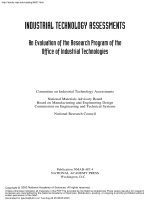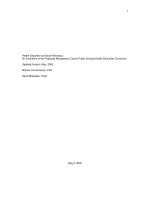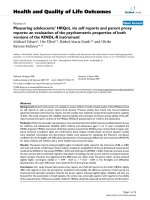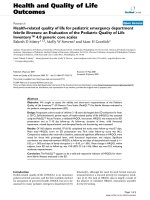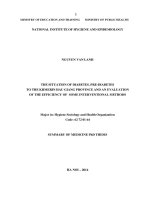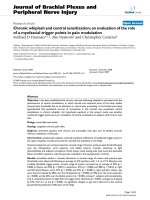ANGLO-SAXON BASED OR GLOBAL BASED CONTENT: AN EVALUATION OF THE COURSE BOOK NEW ENGLISH FILE PRE- INTERMEDIATE FOR FIRST YEAR NON- ENGLISH MAJOR STUDENTS AT ELECTRIC POWER UNIVERSITY
Bạn đang xem bản rút gọn của tài liệu. Xem và tải ngay bản đầy đủ của tài liệu tại đây (992.36 KB, 63 trang )
VIETNAM NATIONAL UNIVERSITY, HANOI
UNIVERSITY OF LANGUAGES AND INTERNATIONAL STUDIES
FACULTY OF POST- GRADUATE STUDIES
-------------------
PHẠM THỊ HẢI YẾN
ANGLO-SAXON BASED OR GLOBAL BASED CONTENT:
AN EVALUATION OF THE COURSE BOOK NEW ENGLISH FILE
PRE- INTERMEDIATE FOR FIRST YEAR NON- ENGLISH MAJOR
STUDENTS AT ELECTRIC POWER UNIVERSITY
(ĐIỂM VỀ NỘI DUNG CUỐN GIÁO TRÌNH NEW ENGLISH FILE PRE- INTERMEDIATE
DÀNH CHO SINH VIÊN KHÔNG CHUYÊN NĂM THỨ NHẤT TRƯỜNG ĐẠI HỌC ĐIỆN
LỰC THEO NỘI DUNG ĐỊNH HƯỚNG ANH MỸ HOẶC ĐỊNH HƯỚNG TOÀN CẦU)
M.A. MINOR PROGRAMME THESIS
Field: English Teaching Methodology
Code: 60140111
Hanoi, 2014
VIETNAM NATIONAL UNIVERSITY, HANOI
UNIVERSITY OF LANGUAGES AND INTERNATIONAL STUDIES
FACULTY OF POST- GRADUATE STUDIES
-------------------
PHẠM THỊ HẢI YẾN
ANGLO-SAXON BASED OR GLOBAL BASED CONTENT:
AN EVALUATION OF THE COURSE BOOK NEW ENGLISH FILE
PRE- INTERMEDIATE FOR FIRST YEAR NON- ENGLISH MAJOR
STUDENTS AT ELECTRIC POWER UNIVERSITY
(ĐIỂM VỀ NỘI DUNG CUỐN GIÁO TRÌNH NEW ENGLISH FILE PRE- INTERMEDIATE
DÀNH CHO SINH VIÊN KHÔNG CHUYÊN NĂM THỨ NHẤT TRƯỜNG ĐẠI HỌC ĐIỆN
LỰC THEO NỘI DUNG ĐỊNH HƯỚNG ANH MỸ HOẶC ĐỊNH HƯỚNG TOÀN CẦU)
M.A. MINOR PROGRAMME THESIS
Field: English Teaching Methodology
Code: 60140111
Supervisor: Dr. Ngơ Hữu Hồng
Hanoi, 2014
DECLARATION
I certify my authorship of the minor thesis entitled “Anglo-Saxon based or
global based content: an evaluation of the course book New English File PreIntermediate for first year non-English major students at Electric Power University”
in terms of the statement of requirements for the thesis and the field study reports in
Masters’ programs is the result of my own work, except where otherwise
acknowledged and that this minor thesis or any parts of the same had not been
submitted for a higher degree to any other universities or institution. I agree that the
origin of my paper deposited in the library can be accessible for the purposes of study
and research.
Hanoi, 2014
Phạm Thị Hải Yến
i
ACKNOWLEDGEMENTS
First and foremost, I would like to express my great gratitude and indebtedness
to my supervisor Dr. Ngo Huu Hoang for his careful instructions, valuable advice and
inspiration during the process of this research.
My sincere thanks also go to all the English lecturers at the Faculty of PostGraduate Studies for providing me useful lectures and suggestions that have helped me
much in my study.
I would like to take this opportunity to extend my deep appreciation to my
colleagues and students at Electric Power University for their cooperation and support
so that I could complete my necessary data collection for the research.
Finally, I wish to thank my family and friends, who have always been by my
side to encourage and support me throughout my study. Without their help and
encouragement, I could not have completed this thesis.
ii
ABSTRACT
This study aims at examining whether Anglo-Saxon culture or global culture is
disseminated in the course book New English File Pre-Intermediate. The data are
collected by using survey questionnaire, interview and document analysis. 150 first
year non-English major students and 5 lecturers at Electric Power University are
employed as participants. The content of the afore-mentioned course book is analyzed
to extract all the possible kinds of culture included in each module. The study finds
that both Anglo Saxon culture and global culture are embedded in the course book;
however, the former is more predominant than the latter. Based on those findings, the
study provides some suggestions for teachers as well as students to improve the quality
of teaching and learning English as an international language.
iii
LIST OF ABBREVIATIONS, FIGURES AND TABLES
ABBREVIATIONS
EIL
English as an International Language
ELT
English Learning and Teaching
EPU
Electric Power University
NEF Pre
New English File Pre-Intermediate
%
Percentage
FIGURES AND TABLES
Figure 1.2.1: Four Senses of Culture
Figure 3.1.2: Students’ opinions about teachers’ frequencies teaching English
integrated into culture in English classroom
Figure 3.1.3: Students’ opinions about the culture representation in the course book
Figure 3.1.5: Students’ opinions about the order of the appearance of kinds of culture
in the course book
Figure 3.1.6: Students’ opinions about preferred kinds of culture to learn
Table 3.1.1: Students’ opinions about learning English integrated into culture
Table 3.1.4: Students’ opinions about the kinds of culture presented in the course book
Table 3.1.7: Students’ opinions about some difficulties of learning English integrated
into culture
Table 3.3.1: Frequency and percentage of the cultural activities in the textbook
Table 3.3.2: Frequency and percentage of Anglo-Saxon culture and global culture in
the textbook
Table 3.3.3: The presence of Anglo-Saxon culture in the textbook
Table 3.3.4: The presence of global culture in the textbook
iv
TABLE OF CONTENTS
DECLARATION…………………………………………………………………..... i
ACKNOWLEDGEMENTS………………………………………………………… ii
ABSTRACT……………………………………………………………………….. iii
LIST OF ABBREVIATIONS, FIGURES AND TABLES…………………………iv
TABLE OF CONTENTS…………………………………………………………… v
PART A: INTRODUCTION………………………………………………………...1
1. Rationale……………………………………………………………………..
1
2. Research Aims and Research Questions…………………………………….
2
3.Significance………………………………………………………………….
2
4.Scope………………………………………………………………………...
3
5.Design………………………………………………………………………
3
PART B: DEVELOPMENT……………………………………………………… 4
CHAPTER 1: LITERATURE REVIEW…………………………………………… 4
1.1
Course books in Language Teaching and Learnin………………………4
1.1.1Definitions of course book, text book and material…………………………… 4
1.1.2 Characteristics of a course book…………………………………………….. 5
1.2
Culture in course books…………………………………………………...7
1.2.1 What is culture?........................................................................................... …7
1.2.2 Culture in course books……………………………………………………… 9
1.3
The role of culture in language learning and teaching …………………10
1.4 Course book Evaluation…………………………………………………...12
1.4.1 Definitions of course book evaluation……………………………………….13
1.4.2 Purposes and the importance of course book evaluation…………………….13
1.4.3 Types of course book evaluation…………………………………………….14
1.5 Summary……………………………………………………………………15
v
CHAPTER 2: METHODOLOGY…………………………………………….16
2.1 Research settings, participants, participant selection methods………….16
2.1.1 Reseach settings……………………………………………………………..16
2.2.2 Participants and participant selection methods……………………………...16
2.2 Descriptions on the course book…………………………………………....17
2.3 Data collection methods……………………………………………………..19
2.4 Data collection instruments…………………………………………………21
2.5 Data analysis procedures……………………………………………………22
2.6 Summary……………………………………………………………………..23
CHAPTER 3: THE STUDY………………………………………………………...24
3.1 Questionaire for students……………………………………………………24
3.2 Interview for teachers……………………………………………………….31
3.3 Document Analysis for the course books…………………………………..33
3.3.1 Culturally oriented activities in the course book…………………………….33
3.3.2 The representation of kinds of culture in the course book…………………..33
3.4 Discussion…………………………………………………………………....36
3.5 Summary……………………………………………………………………..37
PART C: CONCLUSION…………………………………………………………..38
1. Conclusions……………………………………………………………………38
2. Pedagogical implications……………………………………………………..39
3. Limitations of the study………………………………………………………40
4. Suggestions for further research…………………………………………….41
REFERENCES…………………………………………………………………….. 42
APPENDIX 1………………………………………………………………………... I
APPENDIX 2………………………………………………………………………. V
APPENDIX 3……………………………………………………………………… VI
vi
PART A: INTRODUCTION
1. Rationale
Today, English is considered as an international language, and more and more
people use it for a variety of specific purposes. As a result, choosing methodologies,
cultures, and models to teach English as a global language, not a normal language, is
not an easy issue. McKay (2002) states that “it is imperative we examine what goals
and approaches in English language teaching are appropriate for the various kinds of
EIL users.” This leads to that it is complicated and difficult for designing suitable
course books. In Vietnam, a British or American textbook tends to be chosen in ELT,
but its contents mostly relate to native English speaking cultures, which is not
appropriate for teaching EIL.
In addition, whenever it comes to language, culture is always mentioned with it
because language and culture are so closely linked that any change within culture is
reflected in the language and vice versa. As a result, the aspects of language are
expressed through the cultural content in course books. An assumption is given that if
a textbook is composed by native speakers, its orientation of content is Anglo-Saxon
based content. McKay (2002) points out that “Currently, many ELT materials use
cultural topics related to native English-speaking countries on the grounds that
learning English should entail knowledge of native English speaking cultures”. In the
article English as culture action, Prodromou (1988) also shows that one of the reasons
why students are not motivated by culture learning is that the way of presenting culture
in many ELT textbooks. He maintained that “globally designed textbooks have
continued to be stubbornly Anglo-centric. They have not gone far in recognizing
English as an international language either”.
At Electric Power University, the course book New English File PreIntermediate written by Clive Oxenden, Christina Latham Koeing and Paul Seligson
and published by Oxford is used for first year non-English major students. While
1
teaching English, the researcher realizes that the course book seems to be more
inclined to Anglo-Saxon based content than global based content. The elements of
Anglo-Saxon cultures are more probably dominated in the course book than the ones
of global cultures; whereas, nowadays English is regarded as a global language.
Some aforementioned reasons inspire the researcher to conduct the study titled
“Anglo-Saxon based or global based content: an evaluation of the course book New
English File Pre-Intermediate for first year non-English major students at Electric
Power University”.
2. Research Aims and research questions
The study is conducted with the aim of highlighting the role of Anglo- Saxon and
global culture in ELT and reviewing whether the textbook New English File PreIntermediate is Anglo-Saxon based content or global-based content. It also examines
the appropriateness of culture in the textbook with the English teaching and learning
context at EPU. Finally, this study hopes to investigate the ways to help students gain
English more effectively and give some useful suggestions for changing textbooks in
the future. To achieve these aims, two following research questions will be answered
in the end of this thesis:
-
Is the content of the course book inclined to Anglo-Saxon based content or
global based content?
-
What is a cultural course book content perceived by the first year non-English
major students and teachers at Electric Power University?
3. Significance
The findings of the thesis will be useful not only to the researcher, but also to the
teaching staff and the first year non-English major students at Electric Power
University. In addition, the results of the study may be considered as a foundation
towards improving the quality of teaching and learning English as an international
2
language at EPU. The researcher hopes that teachers of English at EPU can use this
course book flexibly and choose a better course book in the future.
4. Scope
Due to the limited scope of time and content of a minor thesis, the research attempts
to review the kind of cultural content in the course book basing on Anglo-Saxon based
and global based content. The researcher will employ 150 first year non-English major
students to fulfill the survey questionnaire and 5 teachers of English for interviewing.
(See clearly in the chapter 2 – Methodology)
5. Design
There are three main parts in this thesis including introduction, development, and
conclusion.
Part A: The introduction provides the rationale, the aims, the significance, the scope,
and design of the thesis.
Part B: The development consists of three chapters:
Chapter one: Literature Review- presents a review of literature concentrating on the
issues related to culture, the role of culture in learning English, cultural content, course
book, textbook and material.
Chapter two: Methodology- focuses on the methodology employed in this thesis
including an overview of current English teaching and learning at Electric Power
University, research methods, and the data collection procedures.
Chapter three: The study- discusses the data, the findings of the study; points out the
strengths, weaknesses, and students’ and teachers’ perception about a cultural course
book content.
Part C: Conclusion and Suggestions- The conclusion provides a brief summary of
all the major parts being presented in the study, makes the conclusions drawn out and
suggests directions for further research.
3
PART B: DEVELOPMENT
CHAPTER 1: LITERATURE REVIEW
1.1.
Course books in Language Teaching and Learning
1.1.1. Definitions
The term “course book” is defined by Ur (1996:183) as “a textbook of which
the teacher and each student has a copy and which is in principle to be followed
systematically as the basis for a language course”. It means that a course book is the
one teachers and students use systematically with the purposes of learning and
teaching in a specific course.
The term “course book” is used to refer to a textbook on which a course is
based. In ELT, it is defined more specifically by Tomlinson (1998) as
A textbook which provides the core materials for a course. It aims to provide
as much as possible in one book and is designed so that it could serve as the
only book which the learners necessarily use during a course. Such a book
usually includes work on grammar, vocabulary, pronunciation, functions and
the skills of reading, writing, listening and speaking.
Encyclopedia of Education gives the explanation about textbooks as follows:
Textbooks are not like other books. Today, textbooks are assembled more than
they are written. They are not usually written by a single author, nor are they a
creative and imaginative endeavor. They are, in fact, usually specially made by
a corporation to follow a set standard curriculum for a school system or larger
organization, such as a province.
In the broad sense of the concept, “textbook” and “course book” are regarded as
“materials” by Tomlinson (1998). He states that “material is anything which is used to
help to teach language learners.” It can be in the form of a textbook, a workbook, a
cassette, a CD-room, a video, a photocopied handout, a newspaper, a paragraph
written on a white board about anything that presents or informs about the language
4
being learned. Materials of these kinds can be obviously exploited effectively for
language learning. However, in the local setting, textbooks seem to be the most widely
used materials in language teaching.
Therefore, within this master thesis the terms “textbook”, “course book”, and
“material” are used interchangeably.
1.1.2. Characteristics of a course book
Textbooks play an important role in language learning and teaching and are
paid much attention to by many authors and researchers. In the field of education,
characteristics of an ELT textbook are on debate.
According to Deuri (2012), a good textbook should have the following
characteristics:
Adequate
Subject
Matter:
The
subject
matter
should
be
based
on
the
psychological needs and interests of students. It should be related to the student’s
environment and have a variety of topics such as prose, poetry, story, biography,
narration, description, etc. In addition, it should be practical utility as well as
informative.
Suitable Vocabulary and Structures: The vocabulary should be controlled, properly
selected and graded. The introduction of vocabulary should be progressive within
the series of readers. The words and structures should be introduced in a systematic
order. The simple meaning should be used a word or structure if they have
more than one meaning. At the end of the text book, a glossary of difficult words and
structures should be given.
Style: The style should be based on the principle of simple to complex. The subject
matter should be presented in a logical manner. The style should be appealing to the
students.
5
Exercises: There should be a sufficient number of exercises at the end of every
lesson. The interactions about the exercises should be brief and clear. The exercises
should be well selected and graded. Different types of exercises should be included.
Illustrations: The illustrations should make the subject matter clear. They should be
sufficient in number. They should be attractive with natural color combination. Too
many ideas should not be conveyed in one illustration.
Proportion and Order: A lesson should not be very long. There should be plausible
proportion between prose, poetry, story, biography, lesson, etc. Two topics should not
be in continuation. Proportion of content and structure should be maintained.
Ansary and Babaii (2002) have different opinions about the standards of a
textbook. According them, four universal features of a good ESL (English as Second
Language) or EFL (English as Foreign Language) are approach, content presentation,
physical make-up and administrative concerns.
Approach is the dissemination of a vision (theory or approach) about the nature of
language, the nature of learning and the application of the theory.
Content presentation includes:
Stating purposes and objectives for the total course and for individual units
Selection and its rationale for coverage, grading, organization and sequencing
Satisfaction of the syllabus to the teachers and to students. For teachers,
textbook provides them with a guide book, gives advice on the methodology,
theoretical orientations, keys to the exercises, and supplementary materials. As
for the student, it gives them piece-meal, unit-by-unit instructions, graphics
(relevant, free from unnecessary details, colorful, etc.), periodic revisions,
workbook, exercise and activities in the classroom, homework, periodic test
sections and accompanying audio-visual aids
6
Physical make-up needs appropriate size and weight, attractive layout, durability, high
quality of editing and publishing and appropriate title.
Administrative Concerns mention macro-state policies, the appropriateness of local
situations such as culture, religion, gender, and appropriate price.
Hutchinson and Waters (1987) also agree that a good material is the one that
gives student a stimulus for learning, offers teachers to organize the process of
teaching and learning. Moreover, it must have a view of the nature of language and
learning, the nature of the learning tasks, and a very useful function in broadening the
basis of teacher training. Finally, a good textbook needs to use the models of correct
and appropriate language use.
All in all, each author has different views about a good textbook. Not all the
ELT materials have all above characteristics; however, teachers should take
consideration carefully to select an appropriate textbook for students and the context of
learning and teaching.
1.2.
Culture in course books
1.2.1. What is culture?
When discussing the term culture, we often refer to music, art, food,
geography, literature, customs, regions, etc. Actually, culture is viewed under many
dimensions and has many different meanings for different authors.
According to Kramsch (1998: 127), culture is “a membership in a discourse
community that shares a common social space and history, and a common system of
standards for perceiving, believing, evaluating, and action”.
Eli Hinkel (1999) also shares the idea that a number of definitions of culture
are the same as “there are the field of inquiry into human societies, groups, systems,
behaviors and activities”
Rogers and Steinfatt (1999) regard culture as “the total way of life of people
composed of their learned and shared behavior patterns, value, norms, and material
7
objects”. It means that culture has influence on the way people lives, thinks, behaves
and speaks in their lives.
However, Adaskou, Britten and Fahsi (1990) view culture under some
dimensions. They classify culture into four senses: the aesthetic, the sociological, the
semantic and the pragmatic sense. They can be seen in the Figure 1.2.1
Culture
The Aesthetic
The Sociological
Sense
Sense
The Semantic
Sense
The Pragmatic
Sense
Figure 1.2.1: Four Senses of Culture (Adaskou, Britten, and Fahsi, 1990)
They refer the aesthetic sense or Culture with a capital C to “the media,
the cinema, music (whether serious or popular) and, above all, literature”
The sociological or Culture with a small c is viewed as “the organization and
nature
of family,
of home
life, sense
of interpersonal
relations,
material
conditions, work and leisure, customs and institutions”
The semantic sense is “the conceptual system embodied in the language
and, according to the Whorf-Sapir Hypothesis, conditioning all our perceptions
and our thought processes. Many semantic areas (e.g., food, clothes, institutions)
are culturally distinctive because they relate to a particular way of life - that is,
to our sociological sense of culture”.
8
Finally, the pragmatic sense refers to “the background knowledge, social
skills, and paralinguistic skills that, in addition to mastery of the language code,
make possible successful sense communication”.
The pragmatic sense includes some following things:
the ability to use appropriate exponents of the various communicative
functions
the ability to use appropriate intonation patterns
the ability to conform to norms of politeness, which is different from the
learners’ culture, including taboo avoidance
the awareness of conventions governing interpersonal relations-questions of
status, obligation, license, where different from the learners’ culture
the familiarity with the main rhetorical conventions in different written
genres such as different types of letters and messages, form-filling,
advertisements
All in all, the different definitions of culture provide with different values.
However, in general, culture involves in the way people from a particular region or
cultural background lives, thinks, behaves and it can distinguish them from the others
and from animals.
1.2.2. Culture in course books
Many authors and researchers reflect the relationship between language and
culture in the field of ELT pedagogy. Carkil (2010) gives the idea that “the lack of
teaching culture or involving culture specific elements in teaching materials leads to
failure to understand and communicate the target language and societies”. Moreover,
Abdullah also adds that cultural understanding should not be disregarded but should be
in the heart of second language learning. So it is very important to disseminate cultural
elements in textbooks.
9
Cortazzi and Jin (1999) divide the cultural information used in language
textbooks and materials into three categories: source culture materials, target culture
materials and international target culture material.
According to Cortazzi and Jin (1999), Source Culture materials refer to the
learners’ own culture as content. Target Culture material address to the culture of a
country where English is spoken as a first language or mother tongue. Finally,
International Target Culture attach to a great variety of cultures in English and nonEnglish-speaking countries around the world. They also claim that “there are EFL
textbooks, produced at a national level for particular countries, which mirror the
source culture, rather than target cultures, so that the source and target cultures are
identical and there are a large number of EFL textbooks that focus on target cultures”.
Basing on the classification of Cortazzi and Jin (1999), Anglo-Saxon based
content is a kind of Target Culture content, in which the British, American, Canadian,
Australian cultures or other cultures adopting English as first language are reflected.
Source Culture here refers to Vietnamese cultures while global based content is a kind
of International Target Culture in the thesis.
Adaskou, Britten and Fahsi (1990) do not also deny the presence of cultural
elements in the textbook. They claim that ELT material can include the cultural
contents. Its content many focus on “some neutral aspect of real life, some exotic
culture, or about specific culture features present in the world of the learner or that of
the speech communities in which the target language is the mother tongue”.
From these above view, it can be suggested that learning and teaching materials
should carry cultural elements and cultural contents.
1.3. The role of culture in language learning and teaching
When it comes to the role of culture in learning and teaching language, Peck
(1998) admits that foreign language instruction is not accurate and complete without
10
the study of language. It is clear that language is a part of culture and it also reflects
culture. Kramsch (1994) discusses the interaction between language and culture. She
points out that teaching language is teaching culture because culture plays a prominent
role in language teaching. Culture and language are interwoven so foreign language
teachers are “involved in handling the meaning of language rooted in socio- cultural
context”. Thus, cultural awareness should become an educational aim in itself
and the core of language teaching.
Bennett (1993) contends that the person who learns a language without its
culture will become a “fluent fool”. It means that he or she can speak a language well
and fluently but does not understand the social or philosophical content of that
language. As a result, when learning a foreign language, it is vital for learners to gather
cultural information for a better communication. In addition, according to McKay
(2003), culture has an effect on language teaching in two dimensions: linguistic and
pedagogical ones. As for linguistics, culture influences the semantic, pragmatic, and
discourse levels of the language. Pedagogically, it affects the choice of the language
materials because cultural content of the language materials and the cultural basis of
the teaching methodology are taken into consideration while deciding upon the
language materials.
Kitao (2000) gives some benefits of teaching culture in language classroom. He
said that learning culture provides students with a reason to study the target
language as if they understand culture clearly, their studying language and literature
will become more meaningful. Learning culture can motivate and increase learners’
curiosity about, interests in target countries. Besides, it can “give learners a liking for
the native speaker of target language”, “help avoid the stereotype” and play a vital part
in general education.
Mentioning the importance of culture in language teaching, Kramsch (2001)
claims that students can realize similarities and differences among a variety of cultural
11
groups by learning culture.
Even, studying culture makes them understand and
tolerate the other people. In addition, the ultimate goal to learn culture is to narrow the
gap between the two cultures and ultimately overcome ethnocentric views. Hence, it is
necessary for language learners to learn culture in language classroom. It will help
them communicate well and adjust themselves to real situations.
From the aforementioned ideas, it is inevitable that culture should be included
into language classroom. The idea for incorporating culture into language teaching and
learning has been concerned by many authors and educators. Many teachers have paid
attention to incorporating culture in their lectures. Politzer, (as cited in Brooks, 1960)
points that
As language teachers we must be interested in the study of culture not because we
necessarily want to teach the culture of the other country, but because we have to
teach it. If we teach language without teaching at the same time the culture in which
it operates, we are teaching meaningless symbols or symbols to which the student
attaches the wrong meaning; for unless he is warned, unless he receives cultural
instruction,
he
will associate American concepts or objects with the foreign
symbols. (p. 85-86).
Moreover, the importance of inclusion of cultural elements in teaching language
has been addressed by many international and national foreign language associations
such as TESOL (Teaching English to Speakers of Other Languages in 1996), ACTFL
(American Council of Teachers of Foreign Languages).
In conclusion, it is that language and culture are inseparable elements so teaching
language should be attached to teaching culture.
1.4. Course book evaluation
As mentioned above, the term “course book”, “textbook” and “material” will be
used interchangeably in this part.
12
1.4.1. Definitions of course book evaluation
Course book evaluation has been concerned by many authors all over the world.
There are many definitions of evaluation perceived by authors as well as teachers.
According to Hutchinson and Waters (1987, p. 96) materials evaluation refers to “a
matter of judging the fitness of something for a particular purpose.” Evaluation is,
then, concerned with relative merit. It is neither absolutely good nor bad - only the
degree of fitness for the required purpose is taken into account. Rossi and Freeman
(1993) also define evaluation as “the systematic application of social research
procedures for assessing the conceptualization, design, implementation, and utility
of… programs”.
However, in language programs, evaluation from the viewpoint of Kiely and
Rea-Dickins may have more meanings than others. It is regarded as “the judgment
about students by teachers and by external assessors; the performance of teachers by
their students, program managers and institutions; and programs, departments and
institutions by internal assessors, external monitors and inspectors” (Kiely and ReaDickins, 2005, p. 5).
From the aforesaid definitions, it can be concluded that “material evaluation is a
procedure that involves measuring the value (or potential value) of a set of learning
materials. It involves making judgments about the effect of the materials on the people
using them”. (Tomlinson, 2003:15).
1.4.2. Purposes of course book evaluation and the importance of course book
evaluation
Course book evaluation serves many purposes. It helps to identify the strengths
and weaknesses of the materials in use. As a result, both teachers and learners need to
evaluate materials to meet their needs, demands and interests. Ellis (1997) gives two
reasons why materials should be evaluated. Firstly, it supplies information to decide
whether materials in use are worthwhile or not. Secondly, it gives teachers the way to
13
modify materials more effectively for future use. Moreover, Sheldon (1988) also
provides some other reasons for material evaluation. He states that the selection of an
ELT often signals an important administrative and educational decision where there is
considerable professional, financial or even political investment. In addition,
evaluation helps the managerial and teaching staff of a specific institution or
organization to discriminate between all of the available materials on the market.
Finally, it supports the educators to identify the particular strengths and weaknesses in
materials in use. It will also assist teachers with realizing the strong points of the
materials in use and adapting the unsuitable exercises, tasks, or activities to meet their
students’ needs and demands.
To conclude, course book evaluation helps us make decision in choosing
textbooks, form professional judgments as well as the awareness of teaching and
learning experiences.
1.4.3. Types of course book evaluation
In materials evaluation field, each author has different classification of
materials evaluation. Tomlinson (2003) divide course book evaluation into three types:
pre-use evaluation, whilst- use evaluation, and post-use evaluation. By contrast,
Robinson (1991:59) classifies materials evaluation into three types: preliminary,
summative and formative. Despite the categories are different, the meanings of these
term are basically similar.
Pre-use evaluation or preliminary relates to the process of making predictions
about the potential value of material for their users.
Whilst- use evaluation or formative refers to the measuring the value of materials
whist using them or whilst observing them being used. It can be more objective and
reliable than pre-use evaluation because it makes uses of measurement rather than
prediction. However, it is limited to measuring what is observable and cannot measure
what is happening in the learners’ brains.
14
Post- use evaluation or summative is normally carried out when the course is
finished with the aim to determine whether the program was successful and effective
and the findings of this evaluation will lead to the decision whether to repeat or use the
materials again or not.
In short, there are different types of materials evaluation so when making an
evaluation; the evaluators have to determine what type of materials evaluation will be
suitable with their work. In the context of English teaching and learning at Electric
Power University, the researcher decided to choose post- use evaluation or summative
to examine whether the course book NEF Pre is effective and suitable for first year
students or not and then could give some recommendations for further improvements
of the material.
1.5.
Summary
This chapter has provided a brief review of literature, which helps to form the
theoretical and conceptual framework for the study. It is divided into four sections. Firstly,
a number of concepts about course book, textbook and material are addressed and some
characteristics of a good textbook are given according to some leading scholars. Secondly,
the definitions of culture and culture in course books are dealt with. Thirdly, the
researcher has given the role of culture in language learning and teaching. Finally, major
issues in course book evaluation such as definitions of course book evaluation,
purposes of course book evaluation, types of course book evaluation are presented
clearly in this chapter.
15
CHAPTER 2: METHODOLOGY
This is survey research including such instruments as Survey Questionnaire,
Interview and Document Analysis, that is, the content of the textbook is analyzed.
2.1. Research settings and participants and participant selection methods
2.1.1. Research settings
The study was carried out at EPU that consists of five majors: Electric System,
Mechanics, Information Technology, Electrical Communication, and Business
Administration. Among them, Electrical System can be seen the most important one
with a large number of students joining the course. English is a compulsory subject at
EPU with 10 credits. Generally, students at EPU learn English for two years. In the
first year, they will be provided with General English by using the course books New
English File Elementary and New English File Pre-Intermediate. In the second year,
they will study English for Specific Purposes. Each year is divided into two semesters;
each lasts 13 weeks and then finishes with the end of examinations. For a General
English course, student will have to take part in 6 periods each week. They will study
five modules from 1 to 5 for the first semester and four rest modules from 6 to 9 for
the second semester. During the term, basing on the levels of students and the number
of the periods, there will be two or three mid-term tests including listening, and writing
test, and at the end of term, they will have to sit for a written test.
2.1.2. Participants and participant selection methods
The participants for the research were 150 first year non-English major students
from three classes at EPU in questioning survey questionnaire and five lecturers
teaching English for the first year students responding to the interview. The research
was carried out randomly only on the first year students of the school year 2013-2014.
They included both males and females but the males outnumbered the females,
ranging from the age 18 to 23. Most of them had learned English for seven years;
16
however, they had different levels of English proficiency because they were from
different places in Vietnam with different background knowledge. Five teachers at
English Division were selected to participate in the research. Both of them were
females and had more than three years in teaching English at English Department,
EPU. All of them have M.A degree in Education or Linguistics. Five teachers agreed
to answer the interview questions enthusiastically.
The researcher decided to choose first year students because first year students
were the direct ones using the course book NEF Pre so they took a balanced view of
the cultural contents in this course book. Besides, the lecturers teaching English for the
first year students were the ones who had full realization of the kinds of culture
presented in the course book NEF Pre. They were supposed to give the most useful
suggestions to help students learn better when using this course book.
For this purpose, this research employed the simple random sampling technique
to select the data from students and lecturers. First year students from three classes and
five lecturers were chosen randomly as for the authenticity and reliability of the study.
2.2. Descriptions on the course book
The course book “New English File Pre-Intermediate” is written by Clive
Oxenden, Christina Latham Koeing and Paul Seligson and published by Oxford
University Press. It consists of 9 modules, each modules includes 4 sub-modules A, B,
C, D with different topics, Practical English, Writing, and Revise and Check. NEF Pre
provides students with an all-round practical knowledge of grammar, skills,
vocabulary, pronunciation and real-life functional language.
In the course book NEF Pre, a typical sub-module is presented with following
sections:
- Grammar: New grammar structures are presented by using pictures, discussion
questions or asking students to read or listen to a conversation. After the forms and the
rules, students have chances to practice with a variety of exercises.
17

